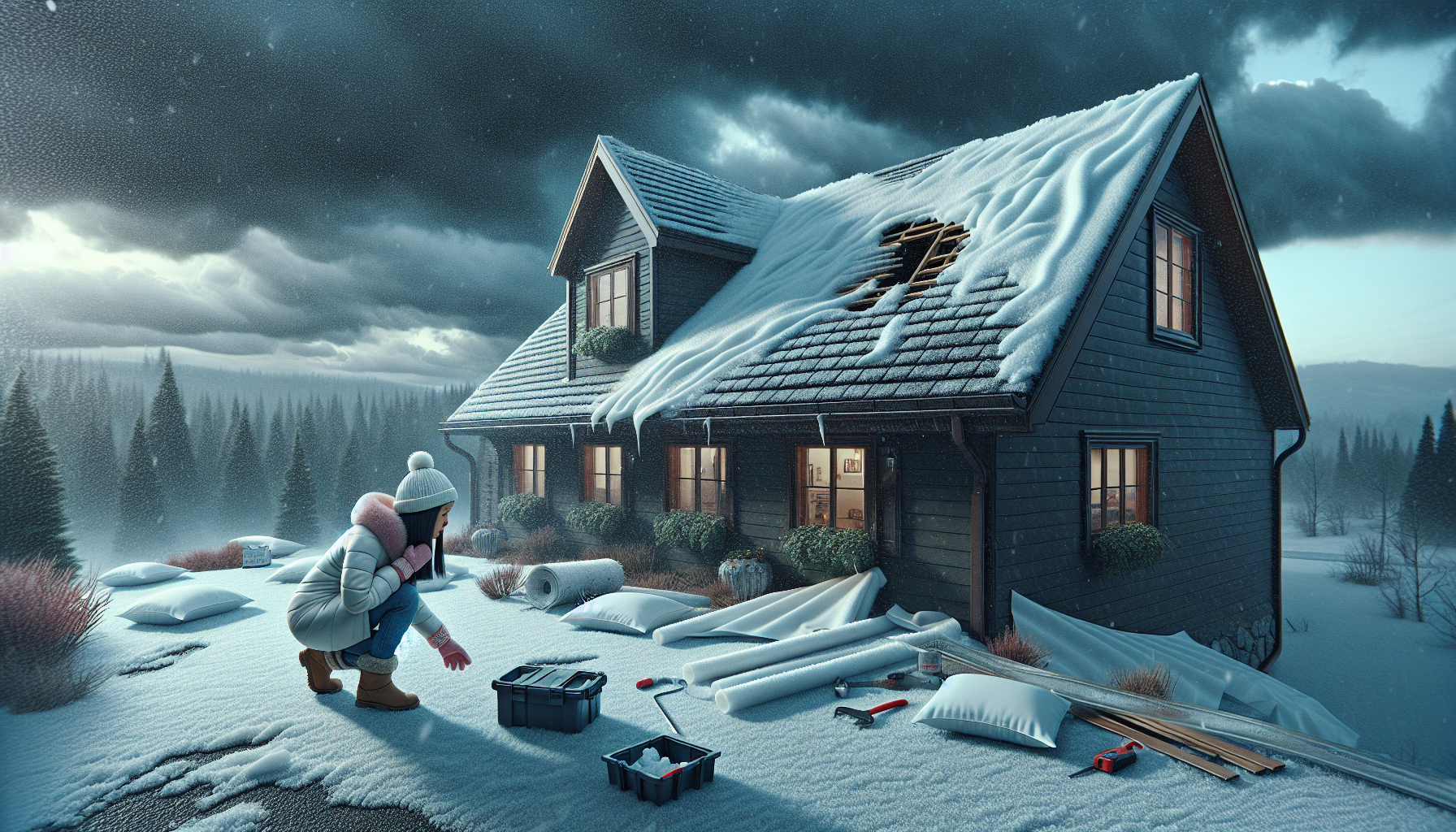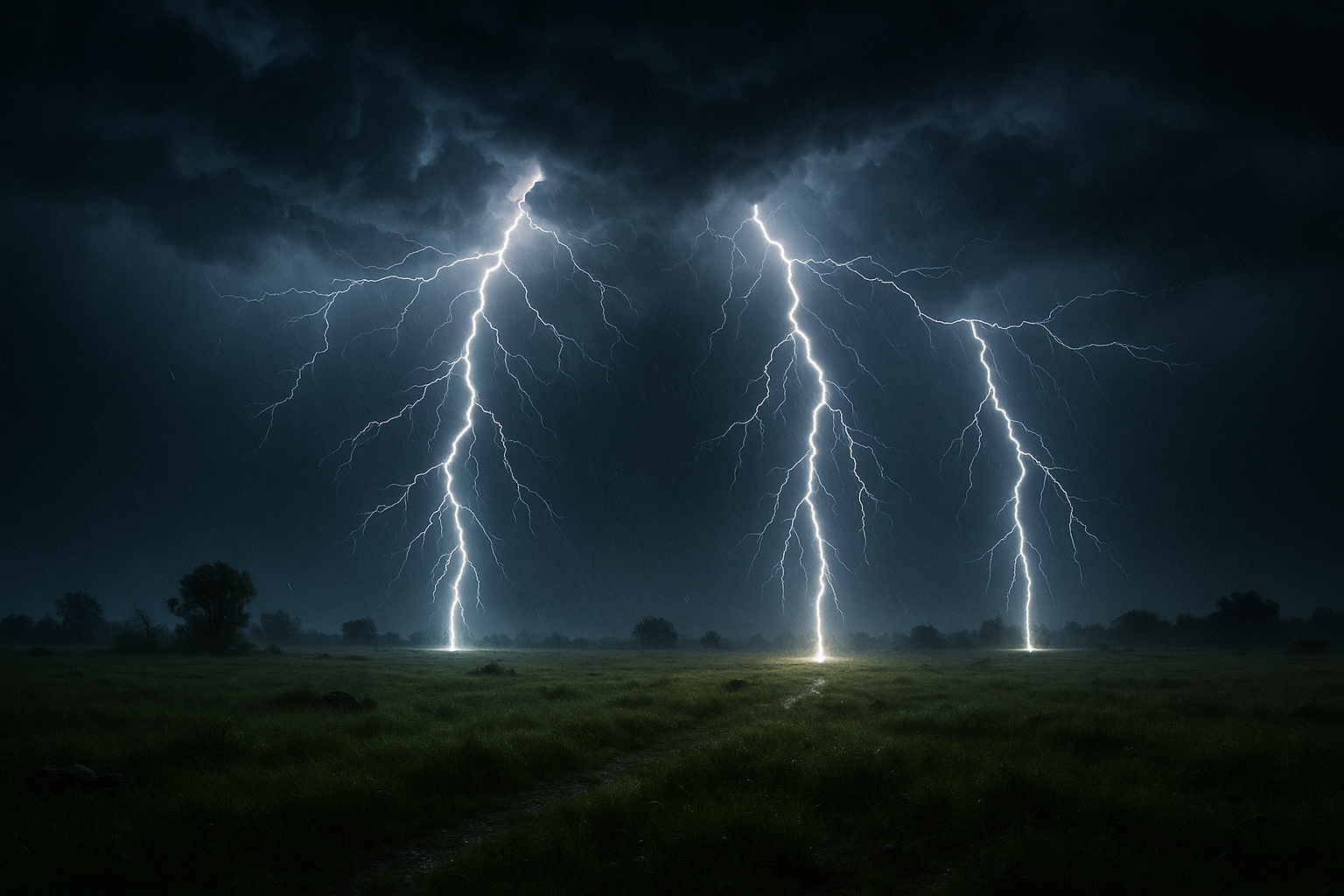When the skies darken and the air becomes electric, we often find ourselves in awe of nature’s raw power. Thunderstorms, with their dramatic flair, captivate our senses and remind us of the grandeur and unpredictability of the natural world. However, hidden within these awe-inspiring displays is a phenomenon that homeowners dread: hail. These icy pellets, often no larger than a marble, can transform a serene afternoon into a scene of chaos, clattering against rooftops and leaving a trail of destruction in their wake. While a single hailstone might seem harmless, the collective impact of a hailstorm can lead to significant and costly damage to one of your most valuable assets—your home. 🏠
Imagine waking up one morning to discover that the storm from the previous night has left your roof battered and bruised, with piles of hail accumulating in vulnerable spots. The damage is not just superficial; it can lead to leaks, structural weaknesses, and a cascade of repairs that can drain your savings and test your patience. Yet, amid this potential for destruction, there is hope. By understanding the dangers that hail poses to your rooftop and taking proactive measures, you can safeguard your home against these icy intruders. In this comprehensive guide, we will delve into the intricacies of hail damage, exploring not only the immediate impact on your home but also the long-term consequences if left unaddressed. We will equip you with practical strategies to fortify your home, ensuring that when the next storm rolls in, you can watch from the safety of your living room, confident that your home is protected. ⛈️
Throughout this article, we will explore a range of topics essential for any homeowner looking to mitigate the risks associated with hailstorms. We’ll start by examining the science behind hail formation and why some regions are more susceptible to these storms than others. Next, we’ll identify the specific ways hail can damage your roof, from compromising shingles to clogging drainage systems. We’ll also address the financial impact, providing insights into insurance considerations and the potential costs of neglecting necessary repairs. Finally, we will offer a suite of preventative measures, from choosing the right roofing materials to scheduling regular inspections and maintenance. By the end of this article, you will be armed with the knowledge and tools to protect your home, ensuring that when the next hailstorm hits, you are ready to weather the storm with resilience and peace of mind. 🌧️
The Impact of Hail on Rooftops
Hailstorms are a common natural phenomenon that can have devastating effects on homes, particularly rooftops. These weather events can occur with little warning and bring with them hailstones of various sizes, each capable of inflicting varying levels of damage. The impact of hail on rooftops is a subject of concern for homeowners, as it can lead to costly repairs and structural issues if not addressed promptly and adequately. Understanding the dangers posed by hail and how it affects your rooftop is crucial for taking preventative measures.
When hailstones strike a roof, the severity of the damage depends on several factors, including the size of the hail, the velocity at which it hits, and the type of roofing material. For instance, asphalt shingles, one of the most common roofing materials, can suffer granule loss, leading to exposure of the underlying matting. This exposure can accelerate the degradation of the shingles, reducing their lifespan significantly. Moreover, repeated hail impacts can cause cracks or even punctures, allowing water to seep through and damage the underlying structure of the roof.
To better illustrate how hail impacts different types of roofing materials, consider the following table. This table highlights common roofing materials and their vulnerability to hail damage:
| Roofing Material | Vulnerability to Hail | Damage Indicators |
|---|---|---|
| Asphalt Shingles | High | Granule loss, cracks, punctures |
| Metal Roofing | Moderate | Dents, paint chipping |
| Clay Tiles | High | Cracks, shattering |
| Wood Shingles | Moderate | Splitting, dents |
Check out this video from Weather Channel on how hail forms and its potential impact on structures.
Preventative Measures to Protect Your Roof
Protecting your home from hail damage starts with proactive measures. By implementing strategies designed to mitigate damage, you can save yourself from expensive repairs and extend the lifespan of your roof. One of the first steps homeowners can take is selecting the right roofing material. Metal roofs, for instance, while susceptible to dents, can withstand hail impacts better than asphalt shingles or clay tiles. If you’re considering a roof replacement, investing in impact-resistant materials might be worthwhile in the long run.
Regular maintenance and inspections are also vital in preventing hail damage. Roof inspections should be conducted at least twice a year, ideally in the spring and fall, to assess the condition of the shingles, check for any signs of wear and tear, and ensure the integrity of the roof’s structure. During these inspections, it’s essential to clear any debris from the gutters and downspouts to prevent water from backing up and causing further damage during a storm.
Consider installing protective barriers like hail guards or impact-resistant covers. These can be applied to skylights and vents, which are particularly vulnerable to hail damage. Additionally, reinforcing your attic insulation can prevent heat loss and contribute to the structural integrity of your roof by reducing the chance of ice dam formation, which can exacerbate hail damage.
DIY Solutions and Professional Services
For those inclined to tackle preventive measures themselves, there are several DIY solutions available. Applying a protective sealant or coating to your roof can help reduce the risk of water penetration following hail damage. These coatings often contain reflective materials that can also improve your home’s energy efficiency. However, while DIY solutions can be effective, they might not offer the same level of protection as professional services.
Engaging with roofing professionals for regular inspections and maintenance can provide peace of mind and ensure that your roof is well-prepared to handle hailstorms. Professionals have the tools and expertise to identify potential weak spots and address them before they become significant issues. They can also advise on the best materials and solutions tailored to your specific geographic area, taking into account the local climate and common weather patterns.
Financial Implications of Hail Damage
The financial impact of hail damage on rooftops can be substantial. Even minor damage can lead to costly repairs, and if left unaddressed, it can escalate into more significant issues such as leaks, mold growth, and structural damage. Homeowners should be aware of the potential costs associated with hail damage and take steps to minimize these expenses through proper insurance coverage and preventive measures.
Homeowners insurance typically covers hail damage, but it’s crucial to understand the specifics of your policy. Some policies might have separate deductibles for wind and hail damage or limit coverage for certain types of roofing materials. Reviewing your policy annually and discussing any concerns with your insurance agent can ensure you have adequate coverage in the event of a hailstorm.
In addition to insurance, maintaining a savings fund for home repairs can provide a financial buffer for unexpected expenses. Proactively addressing minor repairs before they escalate can also reduce overall costs. For example, replacing a few damaged shingles immediately after a storm is significantly cheaper than dealing with water damage or structural repairs down the line.
Comparing Repair Costs and Insurance Coverage
To give a clearer picture of the financial implications, the following table compares average repair costs for different types of roofing materials and the typical coverage provided by homeowners insurance:
| Roofing Material | Average Repair Cost (per 100 sq ft) | Insurance Coverage |
|---|---|---|
| Asphalt Shingles | $300 – $500 | Usually covered, subject to deductible |
| Metal Roofing | $500 – $1,200 | Covered, but cosmetic damage may not be |
| Clay Tiles | $800 – $2,500 | Covered, but may require specific riders |
| Wood Shingles | $400 – $800 | Covered, but may have higher deductibles |
Understanding the nuances of your insurance policy and being prepared for potential repairs can mitigate the financial burden that hail damage can impose on your household budget.
By being proactive in selecting durable roofing materials, regularly maintaining and inspecting your roof, and understanding your insurance coverage, you can significantly reduce the risks and costs associated with hail damage. Investing time and resources into protecting your home from hailstorms is not just about preventing immediate damage but also about ensuring the long-term safety and value of your property. 🌧️

Conclusion
In conclusion, protecting your home from the threats posed by hail accumulation on rooftops is not only a matter of preserving the structural integrity of your property but also an essential step towards ensuring the safety and well-being of everyone who resides within. Throughout this article, we’ve explored various facets of this issue, delving into the mechanics of hail formation, the specific vulnerabilities of different roofing materials, and the potential financial implications of ignoring these risks.
We began by understanding the nature of hail and how it can vary in size and impact, depending on atmospheric conditions. It’s crucial to recognize that even small hailstones can accumulate and cause significant damage over time, especially if your roof is already compromised or aging. This makes regular roof inspections and maintenance an essential preventive strategy. We highlighted the importance of timely repairs and the use of impact-resistant materials to mitigate damage.
Additionally, the role of proper drainage cannot be overstated. Ensuring that your gutters and downspouts are clear and functional is a straightforward yet effective way to prevent water buildup and potential leakage into your home. Moreover, we discussed how the angle and design of your roof can influence hail impact and accumulation, suggesting that consulting with a roofing professional could offer tailored solutions to enhance your home’s resilience against hailstorms.
Investing in protective measures such as storm shutters or hail guards for skylights and windows can further reduce the risk of damage. These installations are particularly beneficial in regions prone to severe weather events. Moreover, understanding your insurance policy and ensuring it covers hail damage is vital in safeguarding your finances against unexpected repair costs.
The environmental and climatic factors contributing to increased hailstorm activity were also considered. As climate change continues to influence weather patterns, the likelihood of severe hailstorms may increase, making preparedness even more essential. By staying informed and adapting to these changes, homeowners can better protect their properties.
We also explored the community aspect of this issue, emphasizing that collective awareness and preparedness can significantly reduce overall damage in hail-prone areas. Encouraging your neighbors to take similar precautions can foster a more resilient community and even lead to potential reductions in insurance premiums due to decreased risk.
Now, more than ever, it is important to take proactive steps in safeguarding your home against hail damage. By doing so, you’re not only preserving your property but also contributing to a broader culture of preparedness and resilience. We encourage you to share this information with friends and family, sparking conversations about protective strategies and fostering a community-oriented approach to disaster preparedness.
To further enhance your understanding and stay updated on best practices for home protection, consider exploring these additional resources:
– National Weather Service on Hail Safety
– Insurance Information Institute – Hail Damage
–
In closing, protecting your home from hail doesn’t have to be a daunting task. By taking informed, deliberate actions, you can prevent costly damage and ensure that your home remains a safe haven for you and your loved ones. Your efforts can inspire others to take similar actions, creating a ripple effect of preparedness and security within your community. Remember, the key to resilience lies in understanding the risks and taking proactive measures to address them. 🌧️🏡
We hope this article has provided valuable insights and motivated you to prioritize the safety of your home. Please feel free to share your thoughts and experiences in the comments below, and don’t hesitate to share this article with those who might benefit from it. Together, we can build stronger, safer communities.
Toni Santos is a visual storyteller and artisan whose creations celebrate the poetry of the natural world. Through his thoughtful artistic lens, Toni captures the elegance of botanical forms, transforming them into meaningful expressions of symbolism, resilience, and timeless beauty.
His journey is deeply rooted in a passion for flora and the mysteries they carry. From the shape of a petal to the curve of a vine, each design Toni brings to life reflects a deeper narrative — one of growth, transformation, and harmony with nature. Whether crafting symbolic floral jewelry, enchanted botanical illustrations, or seasonal visual studies, Toni’s work evokes the quiet magic found in Earth’s most delicate details.
With a background in handcrafted artistry and visual design, Toni blends technique with intention. His creations do more than decorate — they speak, often inspired by ancient meanings behind flowers, the cycles of the seasons, and the invisible bonds between nature and spirit.
As the creative voice behind Vizovex, Toni shares this botanical journey with the world, offering curated stories, handcrafted collections, and thoughtful articles that help others reconnect with nature’s symbolism and artistic essence.
His work is a tribute to:
The quiet power of flowers and their messages
The art of visual symbolism in everyday life
The beauty of slowing down to see what’s hidden in plain sight
Whether you’re an artist, a nature lover, or someone drawn to the deeper meanings behind the natural world, Toni welcomes you to explore a space where aesthetics meet soul — one petal, one story, one creation at a time.





